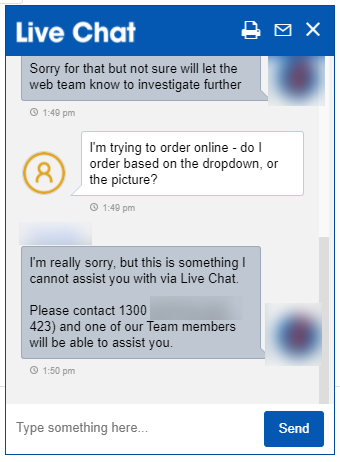I often hear the topic of web-based chat come up both in conversations with customers, and my digging through the web. Some of our customers have already implemented it, some are considering it, and some know it’s not for them. Given the fact that it’s so easy to implement (in most cases a simple code snippet is all that’s needed), it can seem like a great “quick win”. I thought I’d share a couple of recent personal experiences for those of you who are not quite sure whether it’s right for your business. While web chat can be excellent, sometimes just because you can doesn’t mean you should.
Sad customer face #1
Last week I was ordering some food online (I know, all my good stories start with food), and I had a problem with my order. On the order confirmation page, the website had a super handy little “if you’ve got questions click this button and we’ll respond through chat” button. I’ll admit I’m very much of my generation -- I love using chat if given the option. It’s the immediacy of phoning someone, without the disruption. In theory, it should have been awesome.
Unfortunately, theory was the only place it was awesome that day; the reality of it was awful. The staff member took several minutes to respond to me beyond the canned auto-response (“Hi I’m (name), how can I help you?”) and when they DID respond, it was to tell me to just send an email. Are you kidding me? My follow-up question resulted in another minutes-long wait, which ended with the most unhelpful response imaginable: “We are unable to look into it.” Yes, you read that right. They were “unable to look into it.” That bit is actually a direct quote.
Now, whether my experience was because this particular staff member was new, or didn’t have the right support, or was overwhelmed with too many chat windows at once is… well, it’s irrelevant. Ok, that’s not entirely true. It’s irrelevant to me now because I’m no longer interested in giving that company my business. But it’s certainly relevant to them if they’re interested in preventing this from happening to another customer.
Sad customer face #2
My second example is best illustrated by a screenshot of the interaction. For a little background, the “when” of this particular company’s chat was incredibly smart. The chat option only popped up when I went looking for contact options (so there was no disruption to my browsing experience). Like many good things, it seemed that this too, couldn’t last because… well… see for yourself:

ARRRRG!
Which brings me very nicely to the crux of this post: just because you can, doesn’t mean you should. It can be incredibly tempting to look at “hot right now” features like chat. Research indicates that people love using it, and you should give the people what they want, right? Right! Except that people don’t love using it because they get to click on a shiny chat icon. They love using it because:
- It’s fast
- It’s convenient
- It’s less disruptive to their day
If you take even one of those benefits away, it’s no longer the thing people love using. You have set the expectation, then failed to deliver. Which is 100 times worse than not setting the expectation in the first place.
Let’s look at some questions these companies should have asked themselves BEFORE implementing chat:
- Can we meet customer expectations on answer and reply times?
- Can chat operators do everything phone and email staff can?
- How do we reduce pain points for customers who need to contact another department?
- Do we have the systems in place to manage load in busy periods?
There are a few other worthwhile considerations, aside from resourcing:
- Is the platform we’re going to use easy for OUR end user?
- Remember, not all customers have the same level of technical knowledge.
- Do our customers want it?
- If you’re look at chat, consider running it for a month and gaining feedback. Be willing to reassess based on that feedback.
- Is it disruptive to those users who don’t want/need it?
- While you’ll likely have consumers who like using chat (like me!), you’ll also have customers who find it disruptive. It’s important to make sure you’re not alienating one to convenience the other.
Now that I’ve finished tearing into all the reasons why you shouldn’t implement chat (or should at least think twice), I do still think it’s a fantastic communication method. When it works it’s brilliant. BUT it is not a “quick win” for every business. All organisations are different; your customers are different (which means your customer’s pain points are different). Web-based chat may be just what your customers are looking for, but it’s not a guarantee. Before implementing something that feels like “the next hot thing” (especially when it’s something as technically simple to implement as chat) be sure that you’re jumping on that bandwagon because it’s where your customers want to head, not just because it’s shiny and goes ping.
How do you feel about chat as a method of customer service? Love it? Hate it? Think I’m overreacting and I was just a bit hangry? Let me know!

